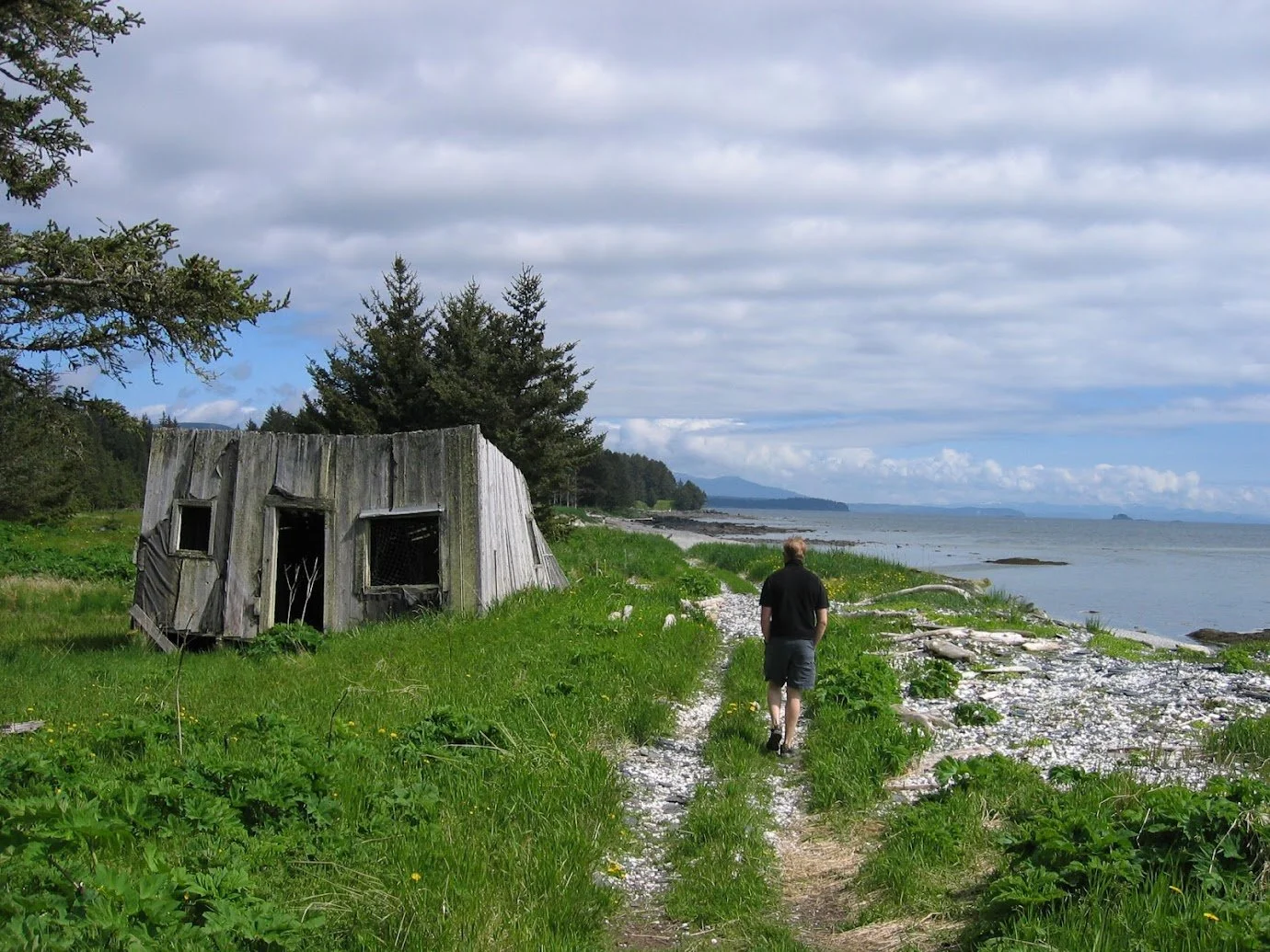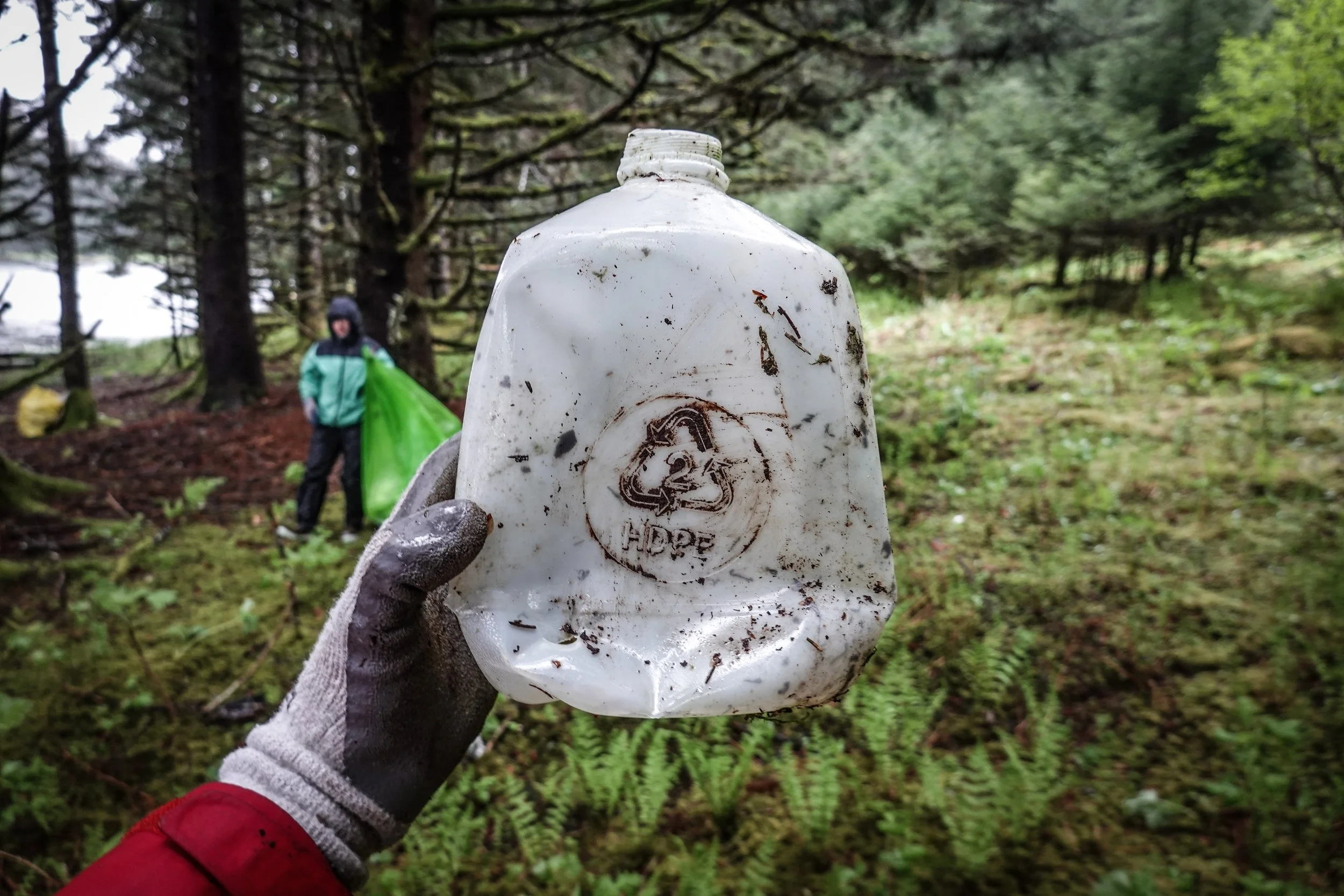OPR Origin Story (Andy’s Version)
On May 23, 2005 while leading a kayaking expedition as a hired guide, I was resting on a beach near on Afognak island. As beachcombers do, I began poking through the wrack line, which consisted mostly of driftwood but as with most Alaska beaches, included a considerable amount of plastic. I hoped to find a glass ball, but instead came across a green plastic frog which later turned out to be one of the legendary Floatees. I kept the toy frog, injection-molded into a Buddha-like pose, strapped to the deck of my kayak as a lookout. The toy seemed out of place, an anthropogenic scar on a landscape which was otherwise pristine. It bothered me, and it bothered my client. I began thinking of ways to mobilize people and equipment to return places like these to their natural state.
Andy walking the beach near the abandoned Afognak village May 23, 2005
My career in the marine debris field started with a simple effort reduce the impact of ocean plastics on people and animals (these plastics included polymers found in net, line and all types of foam). At first I thought this would be as simple as getting some grants, cleaning beaches and ensuring the haul was disposed of properly. For a long time it was that simple; through Island Trails Network, which I founded a year after that fateful kayaking trip, I conducted marine debris clean-ups using local volunteers. We started with vehicle supported cleanups on the Kodiak road system, and graduated to higher-volume projects in higher-impact, remote areas. This was over ten years ago, and the marine debris program is now a familiar and well-established element of Island Trails Network.
A decade ago, disposing of marine debris properly simply meant throwing it in the correct bin. Working through ITN, I had a bigger recycling bin than most; every season we sent 40-foot shipping containers of marine debris to a company in the scrap trader in the pacific northwest. I knew that from there, they went to China. And so it went with marine debris, and pretty much all the recyclables on the west coast of North America. It was fine. Plastics problem solved.
In 2015, the Chinese stopped the import of these recyclable materials into their country, an effort called National Sword, which effectively put a freeze on the export of recyclables in this part of the world, causing commodity prices to plummet. It highlighted the fact that in the U.S. our infrastructure for recycling was woefully inadequate. It also became evident to many that the environmental and social ethics of recycling America’s waste in China hadn’t been such a good idea. Under U.S. laws, recycling can, indeed in must be done better. Slowly at first, and now with a quickening pace, the U.S. is building the infrastructure we need to recycle our own waste.
Meanwhile, 8M tons of plastic worldwide continues to enter the oceans each year. Exactly where the waste is generated is the subject of much conversation and study. There are point sources worth addressing, but much of the damage is already done. For the plastics already in the ocean, the Pacific is distributing it broadly, including here in Alaska. Here at home, my clean-up crews were overwhelmed with the amounts of marine debris found on each new beach, and our removal efforts kept getting bigger and more ambitious as we recognize the severity of the problem. On popular and social media the urgency of the ocean plastics phenomenon, little more than a curiosity ten years ago, is now well-known. People are clamoring for change. But the infrastructure to process all the plastic we produce—even the post-consumer plastic that fills the recycling bins in our cities, is still not in place.
Among all the qualitative categories of plastic, progressing from clean recyclables that are byproducts of industrial processes, to post-consumer plastics (think of the yogurt cup with traces of its contents still inside), to something called ocean bound plastics found in the developing world, which through some benevolent intervention (often by NGOs) are kept from actually reaching the sea. Among all these categories of plastic waste, the bona fide ocean plastics that fill my yard are perhaps the worst. Plastics that have actually crossed the sea may fouled with organics, photodegraded from years in the sun, and if they have come into contact with the shore, may be embedded with rocks and sand. Our product was the least desirable to buyers, and in the wake of National Sword, no one would touch ocean plastics.
A “mountain of trash” on its way from Alaska to Seattle in 2015. Credit is due to GoAK, as well as Island Trails Network for filling up this 30,000 sq ft barge. The haul weighed approximately 1M lbs.
While National Sword was being rolled out I continued my marine debris removal efforts, and in the wake of the 2011 Tohoku Tsunami, actually expanded them. With new regulations brewing and scrap prices falling I found myself stashing marine debris on a donated 1-acre lot without knowing what fate would eventually befall it. I promised myself, and my grantors, that I would work on the “end game.” The mountain of trash grew. And I recognized that I needed help to find an end-of-life solution for ocean plastics.
Number 2 Recyclable jug found on Afognak tossed into the tree-line by a winter storm. Photo by Max Romey.
Fast forward to 2019: With the help of my co-founder Scott and scores of talented people he has introduced me to, OPR is looking at samples of ocean plastics under a microscope, characterizing it polymer by polymer in the largest batches we can find. We hope to identify and share technologies to recapture its value, through recycling or recovery through the extraction of some usable liquid or gas. When these technologies result in demand for ocean plastics, they will require sorting and handling processes, which we are starting to develop now. We hope to find new applications, new markets, and a new home for the 8M tons of plastics which are bound to start coming out of the ocean any day now. They must.



